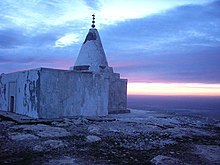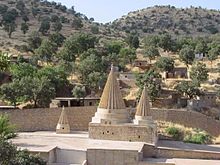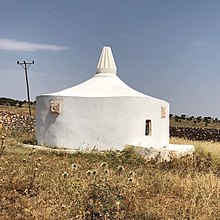List of Yazidi settlements: Difference between revisions
m Dating maintenance tags: {{Source needed}} {{Clarification needed}} |
m Ahmedo Semsurî moved page Ezidkhan to List of Yazidi settlements: no opposition in the talkpage |
(No difference)
| |
Revision as of 17:39, 9 June 2019
This article may be confusing or unclear to readers. (May 2019) |
|
Ezidkhan | |
| Countries[citation needed] | |
|---|---|
| Largest settlements | Sinjar |
Ezidkhan (Arabic: ايزيدخان, Kurmanji Kurdish: Êzîdxan; literally "Land of the Yazidis")[1] is the name of the historical and traditional settlement areas of the Yazidis.[2]
Historically, the Yazidis lived primarily in communities located in present-day Iraq, Turkey, and Syria. However, events since the end of the 20th century have resulted in considerable demographic shifts in these areas as well as mass emigration.[3] Today, the majority of the Yazidi population lives in Iraq and are particularly concentrated in the Nineveh Plains and Sinjar areas in the Nineveh Province in northern Iraq.[4][5] Yazidis in Syria live primarily in the Al-Jazira area and in the Kurd-Dagh.[4][clarification needed]




Historical references
In the 19th century, an autonomous principality existed in the Ottoman Empire, which was called "Êzîdxan" and was ruled by Yazidis. The principality Ezidkhan was in the Redwan region (in the Garzan area, today north of Cizir in Turkey. The Yazidi princes of Ezidkhan defended the principality and were constantly at war against Kurdish princes such as Bedr Khan Bey.[6]
Modern usage
In October 2015 the Yekîneyên Parastina Jin ê Şengalê or YPJ-Sinjar (Women's Defense Units of Sinjar) changed its name to Yekinêyen Jinên Êzidxan or YJÊ (Ezidkhan Women's Units).[7] And in November 2015 the Hêza Parastina Şingal or HPŞ (Protection Force of Sinjar) changed its name to Hêza Parastina Êzîdxanê or HPÊ (Protection Force of Ezidkhan).[8]
See also
References
- ^ Turgut, Lokman (2010). Mündliche Literatur der Kurden in den Regionen Botan und Hekarî (in German). Logos Verlag Berlin GmbH. ISBN 9783832527273.
- ^ "Interview mit Qasim Shesho: Êzîden müssen mit schweren Waffen ausgerüstet werden". ÊzîdîPress (in German). 2014-09-11. Retrieved 2019-04-23.
{{cite web}}: Cite has empty unknown parameter:|dead-url=(help) - ^ Garnik S. Asatrian, Victoria Arakelova (2014). The Religion of the Peacock Angel: The Yezidis and Their Spirit World. ISBN 1317544285. Retrieved 17 May 2019.
- ^ a b Allison, Christine (2004-02-20). "Yazidis i: General". Encyclopædia Iranica. Retrieved 20 August 2010.
- ^ "Question of the Frontier Between Turkey and Iraq" (PDF). Geneva: League of Nations. 20 August 1925. p. 49.
- ^ Turgut, Lokman (2010). Mündliche Literatur der Kurden in den Regionen Botan und Hekarî (in German). Logos Verlag Berlin GmbH. pp. 160–161. ISBN 9783832527273.
- ^ "ANF - Ajansa Nûçeyan a Firatê". Retrieved 16 January 2016.
- ^ "HPŞ benennt sich in HPÊ um: Hêza Parastina Êzîdxan – ÊzîdîPress". Retrieved 16 January 2016.
